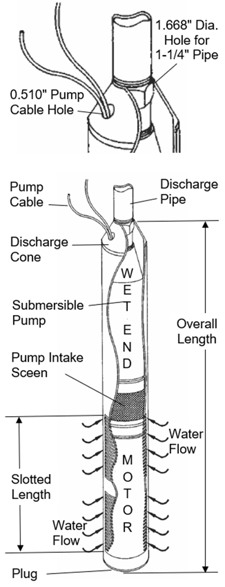What is a pump saver? And how does it work?
What is a pump saver? And how does it work?
 A pump saver is basically a PVC sleeve with slots on the lower end to allow water to enter while keeping sand particulate out. The removable top discharge cap / cone has two holes one for the 1-1/4” drop pipe and a second smaller hole for the pump power cable. The bottom of the pump savers is capped. Both the discharge cone and the bottom cap are fastened using stainless steel screws.
A pump saver is basically a PVC sleeve with slots on the lower end to allow water to enter while keeping sand particulate out. The removable top discharge cap / cone has two holes one for the 1-1/4” drop pipe and a second smaller hole for the pump power cable. The bottom of the pump savers is capped. Both the discharge cone and the bottom cap are fastened using stainless steel screws.
Pump savers are installed over your submersible pump and are ideal for protecting your pump from premature wear on the impellers and diffusers from abrasive sand when pumping from water wells, lakes, ponds, rivers, and canal waterways.
Cooling the Motor
The reason that the bottom is capped and only the lower section is slotted is to ensure that all the water being pumped is drawn through the slots below the pump’s intake screen. This ensures that the water flows over the submersible motor to provide adequate cooling.
Installation
The Canadian Electrical Code has changed with regards to installing submersible pumps in bodies of water. For more information visit the link below for an article “2021 Canadian Electrical Code changes regarding pump cable for submersible pump installation, in Deep Well and Bodies of Water.”
Use a silicone sealant rated for potable water applications (NSF-61 Certified) to seal off gaps or openings around the wires and the drop pipe to prevent drawing sand or debris in through the gaps.
WARNING: Most submersible pumps must be installed on an angle to prevent damage to the thrust bearings. Always refer to and follow the pump manufacturer's installation instructions for horizontal installation requirements.
Slot Sizes & Flow Capacity
The screens are available in two slot widths 0.010” and 0.040”. The chart below provides dimensional and flow capacity information.
Pump Saver Part No. Description
PWPS40-60-010 4" x 60" PVC PUMP SAVER - .010
PWPS40-60-040 4" x 60" PVC PUMP SAVER - .040
Dimensions and Flow Capacity

IMPORTANT:
It is crucial that you always refer to and follow the manufacturer's installation instructions, as well as ALL applicable plumbing and building codes (National and local). When applicable there may be well construction codes as well.
In Conclusion
We trust this information has been helpful, however you may want to read more about other FAQs on plumbing and water well topics. Visit our Knowledge Base sight on our website www.bosahrt.com or at the link https://support.boshart.com/. You will also find a lot of information in the regularly posted blogs https://blog.boshart.com/ or in the literature section https://boshart.com/literature/.
